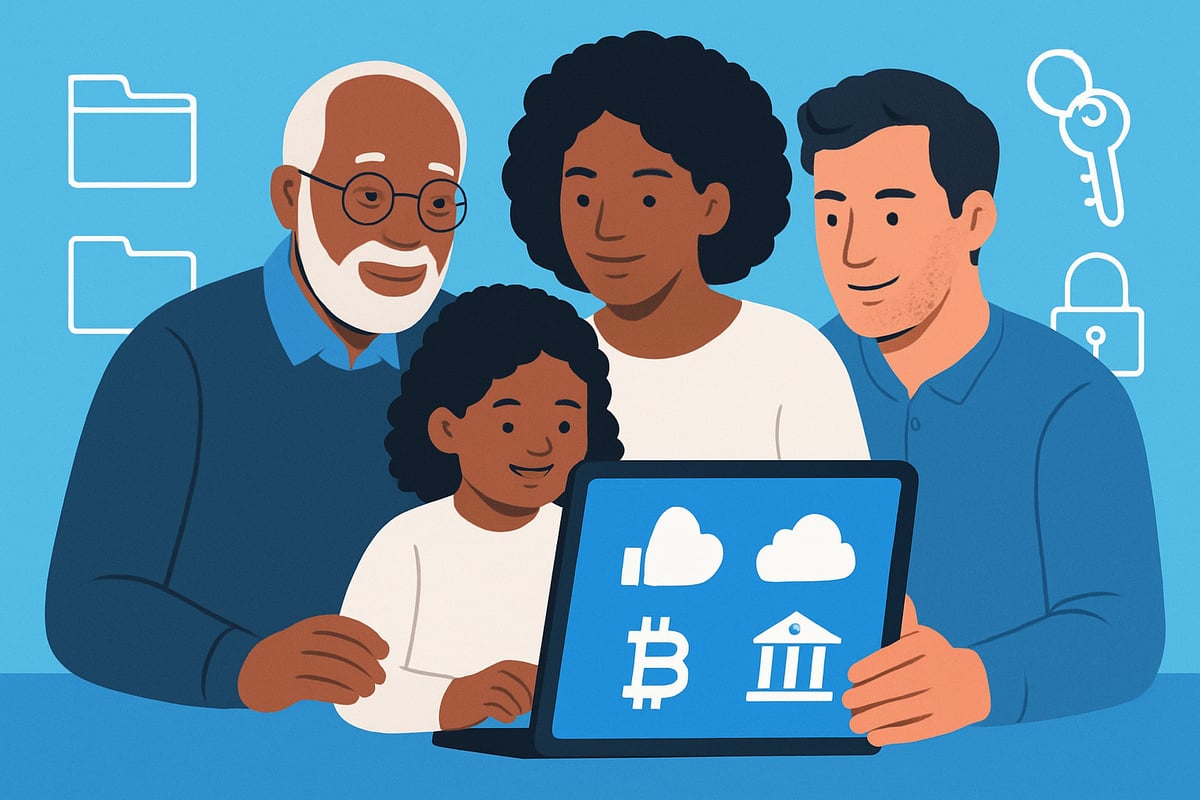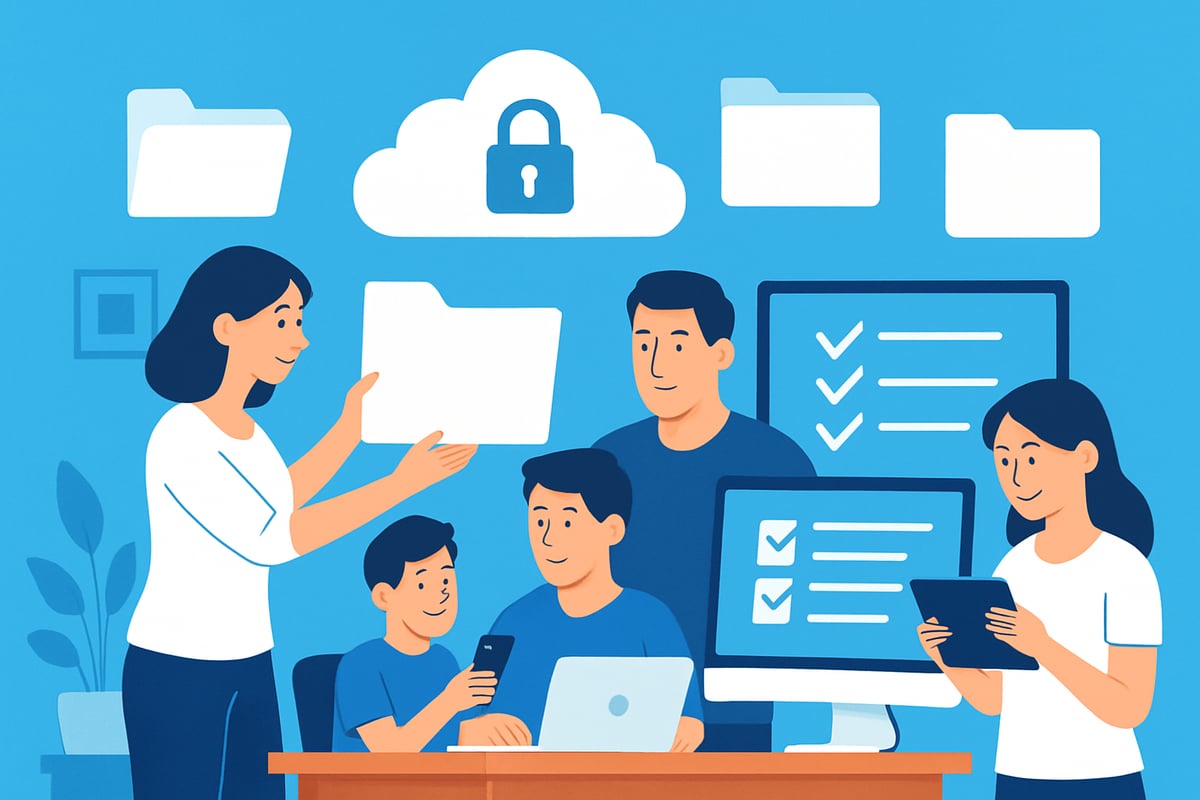Imagine your loved ones unable to access your online accounts, digital assets, or treasured memories when you are no longer here. Today, our lives are more digital than ever, so digital estate planning is now a must for protecting what matters most.
This essential guide will show you how to safeguard your digital presence in 2025. You will learn what digital estate planning is, why it is crucial, how to organize assets, legal steps, and best practices to secure your digital legacy. Ready to ensure peace of mind for your family? Let’s get started.
Understanding Digital Estate Planning
Our lives are more digital than ever, yet most people overlook digital estate planning. This process ensures your online presence, accounts, and digital assets are organized and accessible for your loved ones. As we move into 2025, digital estate planning is no longer optional—it’s essential for anyone with an online footprint.

Defining Digital Estate Planning
Digital estate planning is the process of organizing, securing, and preparing your digital assets for management or transfer after you pass away. Unlike traditional estate planning, which focuses on physical property and finances, digital estate planning addresses assets like social media accounts, cryptocurrencies, cloud documents, and digital payment services.
This approach has evolved rapidly. In 2025, a typical digital estate includes everything from Facebook profiles and Google Drive files to NFTs and blogs. The complexity grows as more of our financial and personal lives move online. Consider the following examples:
| Digital Asset Type | Examples |
|---|---|
| Social Media | Facebook, Instagram, LinkedIn |
| Cloud Storage | Google Drive, Dropbox, iCloud |
| Cryptocurrency | Bitcoin, Ethereum, NFTs |
| Payment Accounts | PayPal, Venmo, Apple Pay |
| Intellectual Property | Blogs, YouTube, Podcasts |
The importance of digital estate planning is underscored by recent statistics: over 60% of Americans have valuable digital assets, but only 20% have included them in estate plans. For more insight, see these Estate Planning Awareness and Education Statistics.
Many assume digital assets are automatically transferred to heirs, but this is a common misconception. Without clear instructions, accounts may be locked, deleted, or lost forever. As our digital footprints expand, digital estate planning has become crucial for safeguarding both financial and sentimental value.
Why Digital Estate Planning is Crucial in 2025
The risks of neglecting digital estate planning are greater than ever. After someone passes away, their online accounts can become targets for identity theft or cybercrime. Digital-only assets like cryptocurrency and NFTs are especially vulnerable—if the keys or recovery phrases are lost, these assets are gone forever.
There’s also enormous emotional value in digital memories. Family photos, personal emails, and private messages are often stored online. Without a plan, loved ones may struggle to access these cherished items, adding stress to an already difficult time.
Legal challenges can complicate things further. Heirs often face strict privacy laws and changing tech company policies that restrict access to accounts. For instance, a family might be unable to access a deceased relative’s online bank account if credentials are missing or authority isn’t clearly documented.
Remote work and paperless statements make assets harder to discover. As more people manage finances and business exclusively online, digital estate planning ensures nothing slips through the cracks. By planning ahead, you protect your legacy and give your family peace of mind.
Identifying and Cataloging Your Digital Assets
As you dive into digital estate planning, the first step is understanding what counts as a digital asset. In today's world, your online life can be just as valuable as your physical property. Creating a clear inventory ensures nothing important is overlooked, and your loved ones can easily manage your digital legacy.

Types of Digital Assets to Include
Digital estate planning covers a surprisingly broad range of assets. Here are some key categories you should consider:
- Financial accounts: Online banking, investment platforms, and retirement accounts.
- Social media: Facebook, Instagram, Twitter, LinkedIn, and TikTok profiles.
- Email and cloud storage: Gmail, Outlook, Google Drive, Dropbox, and iCloud.
- Digital payment services: PayPal, Venmo, Apple Pay, and Google Pay.
- Blockchain and crypto assets: Bitcoin, Ethereum, and NFTs.
- Loyalty and rewards points: Airline miles, hotel points, and store rewards.
- Intellectual property: Blogs, YouTube channels, podcasts, and online courses.
- Digital media: Photos, music, videos, and eBooks.
Think about every online account, subscription, or service you use. Even seemingly minor assets, like unused loyalty points, can add value to your digital estate planning. Make a habit of considering both financial and sentimental assets, as family photos or personal messages are often irreplaceable.
Creating a Comprehensive Digital Asset Inventory
A thorough inventory is the backbone of digital estate planning. Start by listing every online account and digital asset you own. Use a checklist or template to make this process easier and ensure you do not miss anything.
Here is a simple step-by-step approach:
- List all digital accounts: Record usernames, email addresses, and platforms.
- Note account numbers and URLs: This helps heirs find the correct login pages.
- Identify recurring payments: Subscriptions and memberships can drain funds if overlooked.
- Classify assets: Group them as financial, sentimental, or privacy-sensitive.
- Document special instructions: For example, specify if an account should be deleted or memorialized.
Some people write an "I Love You" letter, which is a non-legal document listing all assets and wishes. Review and update your inventory regularly, especially as new accounts are added or old ones closed. Digital estate planning is most effective when your records are current and complete.
Storing Access Information Securely
The security of your digital estate planning depends on how you manage access details. Never write passwords or sensitive data directly in your will, as these documents can become public.
Instead, consider these best practices:
- Use a password manager: Store usernames, passwords, and even two-factor authentication methods securely.
- Handle crypto keys with care: Write down wallet recovery phrases and store them offline in a fireproof safe.
- Make encrypted backups: Save digital copies of your inventory and access info.
- Physical security options: Place a secure thumb drive with access details in a bank safe-deposit box.
Remember, sharing passwords over email or in unsecured places increases risk. By protecting this information, you help prevent identity theft and ensure your digital estate planning process is safe for your heirs.
Organizing Your Digital Estate with The Family Binder
For a practical way to manage your digital estate planning, consider using The Family Binder. This tool provides editable, printable PDFs designed for easy updating and secure storage. It includes sections for online accounts, financials, insurance, and estate documents.
The Family Binder is perfect for families, caregivers, and retirees looking to keep digital and physical assets organized in one place. It brings peace of mind by making sure your loved ones can quickly find what they need in an emergency. For more on how this tool streamlines the process, check out How the Family Binder Simplifies Estate Planning.
By organizing your information now, you set up your digital estate planning for lasting success and security.
Legal Considerations and Digital Asset Access
Navigating the legal landscape of digital estate planning in 2025 can feel overwhelming. With so many types of digital assets and ever-changing regulations, it’s more important than ever to understand your rights and responsibilities. Let’s break down the key legal factors you need to know to protect your digital legacy and make sure your wishes are honored.
Understanding Digital Ownership and Rights
Digital estate planning starts with knowing what you truly own online. Many assets, like purchased music or eBooks, are only licensed, not owned outright. This means your right to use them may not extend to your heirs.
Here’s a quick comparison:
| Asset Type | Owned or Licensed | Inheritable? |
|---|---|---|
| Cryptocurrency | Owned | Yes, with access |
| Social Media | Licensed | Limited/No |
| eBooks/Music | Licensed | Usually No |
| Photos (uploaded) | Owned | Yes, if accessible |
Platform policies matter, too. For example, Facebook lets you set a legacy contact, while Google’s Inactive Account Manager allows you to decide what happens to your data. Apple now offers a Legacy Contact feature as well. Always review each service’s terms to see how your digital estate planning can be honored.
Appointing Digital Executors and Power of Attorney
A digital executor is the person you trust to manage your online accounts and assets after you’re gone. Their responsibilities include closing accounts, transferring data, and following your wishes for each asset.
To appoint one, you must name them in your will or trust. Some states recognize digital executors by law, while others follow the Revised Uniform Fiduciary Access to Digital Assets Act (RUFADAA) to define their authority.
Consider granting power of attorney for digital assets if you become incapacitated. Without clear legal authority, even close family may be locked out of important accounts. For example, an executor without explicit permission might be unable to access digital-only bank accounts, causing stress and delays.
Including Digital Assets in Legal Documents
To ensure your digital estate planning is effective, reference your digital assets directly in your will or trust. Do not include passwords or sensitive data in these documents, since they become public during probate.
Instead, provide instructions on how to access, transfer, or delete each account. Here’s a sample clause:
I direct my executor to access and manage all digital assets, including email, cloud storage, and cryptocurrency, according to the inventory provided separately.
Update your documents regularly as your digital life evolves. For a step-by-step approach to integrating digital assets into your estate, see the Estate Planning Guide for Families.
Privacy, Security, and Compliance Issues
Balancing access for heirs with security is a top concern in digital estate planning. Granting too much access can open the door to identity theft or fraud, especially after death. Deceased individuals are particularly vulnerable to impersonation.
Stay compliant with privacy laws like GDPR and CCPA, which may affect how your data is handled. Communicate access instructions securely, using encrypted methods or trusted, in-person conversations. Protecting your privacy while ensuring your heirs can manage your digital legacy is a delicate but essential part of planning.
Step-by-Step Guide to Creating Your Digital Estate Plan
Getting started with digital estate planning can feel overwhelming, but breaking it down into manageable steps makes the process straightforward. This guide will walk you through each essential phase, ensuring your digital assets are protected and your loved ones can access what matters most.

Step 1: Inventory and Assess Your Digital Assets
Start your digital estate planning by listing every digital account, file, and asset you own. Review your online banking, investment platforms, social media, email, cloud storage, crypto wallets, loyalty points, and content like blogs or photos.
Organize assets by their financial, sentimental, or privacy value. For each, decide whether you want it transferred, deleted, or memorialized in the future. Use a checklist to avoid missing hidden accounts or subscriptions.
Keep your inventory updated as your assets change. This foundational step ensures your digital estate planning covers the full scope of your digital life.
Step 2: Secure Your Access Information
Once your inventory is complete, focus on securing access details for each asset. Store usernames, passwords, and two-factor authentication methods in a reliable password manager with legacy access features. Back up critical credentials and crypto keys offline, such as in a fireproof safe or secure vault.
For more ideas, check out Digital Record Keeping Tips for practical strategies. Keeping this information organized and protected is essential to digital estate planning.
Regularly update and test your access instructions for accuracy and security.
Step 3: Choose and Appoint Your Digital Executor
Choosing a digital executor is a crucial part of digital estate planning. This person should be trustworthy, organized, and ideally tech-savvy.
Formally appoint your digital executor in your will, trust, or power of attorney documents. Clearly communicate their responsibilities, providing them with secure access to your inventory and instructions.
Let your executor know where to find your digital estate plan and how to use your password manager or backup storage. This ensures your wishes are carried out smoothly and efficiently.
Step 4: Document Your Wishes and Instructions
Write clear, concise instructions for each digital asset in your inventory. Specify whether accounts should be transferred, deleted, or memorialized, and outline any special handling for sensitive information.
You might use an “I Love You” letter or a similar document for personal notes that supplement your legal plan. Digital estate planning works best when instructions are easy to understand and up to date.
Keep these documents separate from your will, and store them securely where your executor can access them.
Step 5: Update Legal Documents
Work with your attorney to add digital asset clauses to your will and trust. These clauses should reference your digital asset inventory and appoint your digital executor, ensuring legal authority over your online accounts.
Avoid including passwords in legal documents for security reasons. Instead, point to your securely stored inventory. Digital estate planning requires legal documents to reflect your evolving digital footprint.
Review and update your documents regularly as your assets and preferences change.
Step 6: Communicate Your Plan
Inform your digital executor and key family members about your digital estate planning process and where to find your plan and credentials. Open communication reduces confusion and ensures your wishes are respected.
Discuss especially sensitive or high-value assets in person or via secure channels. Encourage questions and clarify any uncertainties to promote confidence and peace of mind.
Ongoing communication is essential for a seamless transition of your digital legacy.
Step 7: Review and Update Regularly
Digital estate planning is not a one-time task. Set reminders to review your digital asset inventory, access information, and legal documents at least once a year or after major life events.
Update your plan when you open new accounts, acquire crypto, or change passwords. Remove obsolete entries and add new ones as needed. Staying current ensures your digital estate plan remains effective and secure.
A proactive approach keeps your digital legacy protected for years to come.
Best Practices for Securing and Protecting Your Digital Legacy
In a world where our lives are increasingly online, protecting your digital legacy is just as crucial as safeguarding your physical assets. Effective digital estate planning ensures your loved ones can access your accounts, memories, and investments without unnecessary hurdles. Let’s explore key best practices to help you secure every corner of your digital life.
Consolidate and Simplify Accounts
Start by reviewing all your online accounts. The more accounts you have, the harder it becomes for your heirs to track everything down. Close old or unused accounts to reduce digital clutter and limit security risks.
- Delete redundant social media and email accounts.
- Cancel outdated subscriptions and services.
- Merge duplicate profiles where possible.
This streamlining process is a cornerstone of successful digital estate planning, making it easier for your executor to manage your digital footprint.
Back Up Critical Digital Assets
Do not rely solely on the cloud. Regularly back up vital photos, documents, and videos to external hard drives or secure cloud storage. Store these backups in a fireproof safe or a bank safe-deposit box for added safety.
Consider these backup tips:
- Use multiple backup methods (cloud and physical drives).
- Test your backups periodically to ensure files are accessible.
- Document the backup locations in your digital estate planning inventory.
This redundancy protects your most cherished files from accidental loss or cyberattacks.
Use Strong Security Measures
Cyber threats never rest. Enable two-factor authentication (2FA) on important accounts, choose unique and complex passwords, and use a trusted password manager. Regularly monitor for suspicious activity, especially after major life events.
Sample table of security tools:
| Tool | Purpose |
|---|---|
| Password Manager | Store and share credentials |
| 2FA Authenticator | Add extra login security |
| Encrypted Storage | Secure sensitive files |
Strong security practices are vital for digital estate planning, helping prevent unauthorized access and identity theft.
Keep Beneficiary Designations Up to Date
Many financial and digital platforms now allow you to name beneficiaries directly. Review these designations at least once a year.
- Update beneficiaries after major life changes.
- Check for transfer-on-death (TOD) options on investment accounts.
- Coordinate designations with your will to avoid conflicts.
This step ensures your digital assets transfer smoothly and according to your wishes.
Plan for Blockchain and Crypto Assets
Blockchain assets like Bitcoin and NFTs require special attention. Store wallet keys and recovery phrases offline, such as in a safe or safety deposit box. Without these, your assets could be lost forever.
- Create a clear instruction sheet for your heirs.
- Test recovery processes with small transactions.
- Include crypto details in your digital estate planning documents.
For more insights on emerging trends and technologies, check out Digital Estate Planning Trends 2025.
Manage Intellectual Property and Digital Content
If you own a blog, YouTube channel, or digital course, ensure you specify who inherits these assets. Ongoing revenue streams or valuable content need clear management instructions.
- List usernames, URLs, and access credentials.
- Address copyright or trademark issues.
- Name successors for ongoing projects.
Thoughtful management of digital content is a growing part of digital estate planning.
Regular Communication and Education
Finally, talk openly with your family and digital executor about your plan. Share where your inventory and instructions are stored, and educate heirs about potential risks.
- Schedule annual check-ins to review your plan.
- Encourage questions and feedback.
- Provide guides or checklists for less tech-savvy heirs.
Regular communication ensures your digital estate planning efforts are actually effective when the time comes.
Common Challenges and Mistakes in Digital Estate Planning
Digital estate planning is essential, but even the most careful individuals can make mistakes that put assets and memories at risk. As digital assets become a bigger part of our lives, addressing these challenges is crucial to safeguard your legacy and protect your loved ones.
Overlooking Hidden or Obscure Digital Assets
Many people forget about old email addresses, dormant subscriptions, or small-value loyalty points when creating their digital estate planning inventory. These overlooked assets can hold sentimental or financial value, and their loss may go unnoticed until it's too late. A simple, thorough checklist can help ensure nothing slips through the cracks.
Inadequate Documentation or Access Instructions
Without clear, current instructions for accessing accounts, even the most sophisticated digital estate planning can fail. Passwords, two-factor authentication methods, and crypto keys must be securely documented. Relying on memory or informal notes is risky, as heirs may be locked out of crucial accounts, unable to recover important data or funds.
Legal and Compliance Pitfalls
Assuming executors automatically have access to all online accounts is a common misconception. In reality, laws and tech company policies are complex and ever-changing. Not updating legal documents to reflect digital assets can lead to major headaches for heirs. It's important to stay informed about state-specific laws and global regulations. For example, the Digital Estate Planning Market Growth highlights how the increasing value and prevalence of digital assets demand careful legal attention.
Security Risks and Privacy Breaches
Storing sensitive credentials in unsecured locations, like sticky notes or unencrypted files, introduces the risk of hacking and identity theft. Sharing passwords via email or text can also expose accounts to cybercriminals. Regularly reviewing and updating your security practices is a vital part of digital estate planning, protecting your digital legacy from evolving threats.
Failing to Communicate with Heirs and Executors
Not informing trusted individuals about your digital estate plan or its location can leave heirs confused and assets stranded. Clear, proactive communication ensures your wishes are understood and followed. Misunderstandings can lead to lost assets or even family disputes, making transparency a core best practice.
Outdated Plans and Lack of Regular Review
Digital assets change rapidly, and plans can become obsolete if not maintained. New accounts, password changes, or closed platforms mean your digital estate planning documents should be reviewed at least annually. Overlooking this step is a leading cause of inaccessible or lost digital property.
Real-World Examples and Lessons Learned
Consider these scenarios: an executor unable to access a crypto wallet due to a missing key, or family photos lost when a cloud account is deleted after inactivity. These cases highlight why only 20% of Americans have included digital assets in their estate plans, despite the growing need. As our definition of legacy expands to include digital footprints, Expanding the Definition of Legacy offers valuable insights on why comprehensive digital estate planning is more important than ever.
| Common Mistake | Potential Impact |
|---|---|
| Missing obscure assets | Lost value/memories |
| Poor documentation | Heirs locked out |
| Legal oversights | Delays, disputes |
| Security lapses | Fraud, identity theft |
| Lack of communication | Confusion, conflict |
| Outdated plans | Assets inaccessible |
Learning from these challenges can help you build a stronger, more resilient digital estate plan that truly protects your legacy.
You’ve learned how important it is to keep your digital life organized and accessible for your loved ones, especially as our world gets more digital every day. If you’re ready to put these steps into action and give your family real peace of mind, I recommend using The Family Binder. It’s an easy-to-use, printable PDF that helps you track everything from online accounts to insurance details, all in one place. You don’t have to worry about anyone scrambling for passwords or important info in an emergency. Take the first step and Download Now.

